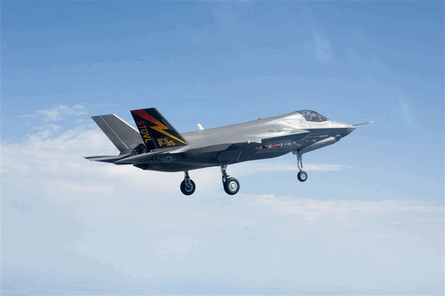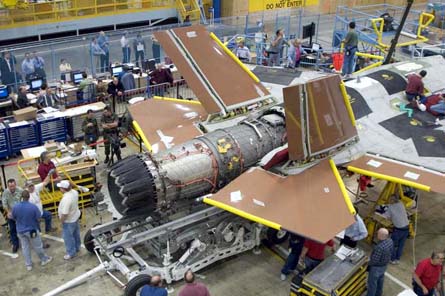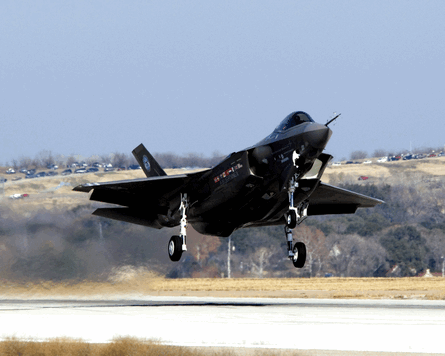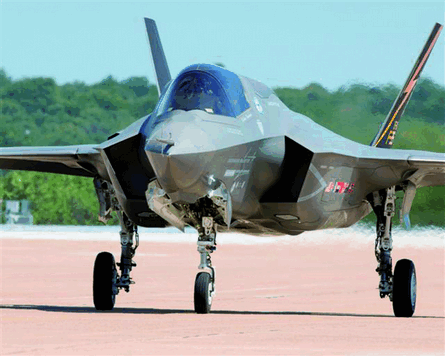Production activity for the Lockheed Martin F-35 Joint Strike Fighter is entering the start of an intense phase that will dominate the programme's energies for the next 18 months.
Since November 2006, getting the first weight-optimised and short take-off vertical landing prototype aircraft in the air on time was the programme's primary focus, even as the first AA-1 conventional aircraft began flight tests in December 2006.
The path to realising the STOVL milestone was obstructed by the discovery earlier this year of a persistent problem affecting the endurance of turbine blades in the Pratt & Whitney PW135 engine. A permanent solution to the problem is under study, and the delay cost the schedule fewer than three weeks.
 |
|---|
© Lockheed Martin |
The successful flight debut on 11 June of the first STOVL airframe named BF-1 in conventional mode did more than satisfy the programme's ability to make good on a promise made 18 months before.
The flight also pushed the programme's internal focus beyond the first flight milestone for aircraft BF-1, and into a perhaps even greater challenge: escalating the pace of final assembly work.
Outwardly, flight-test efforts will continue to capture public interest in the programme. The Lockheed-led industry team's focus will shift from getting BF-1 flying to steadily preparing the prototype for its first flight in STOVL mode, an event previously scheduled to occur by the end of the year, but now planned for early 2009.
Meanwhile, Lockheed's assembly line is just at the beginning of a dramatic surge of activity. Since the system development and demonstration phase began in October 2001, and taking into account a roughly 18-month delay to resolve a major weight problem, the programme's production system has completed delivery for the first two prototypes only.
Now, under a third revised production schedule unveiled in May, Lockheed's final assembly and check-out facility in Fort Worth, Texas, is committed to deliver new prototype airframes at the rate of one completed aircraft a month for each of the next 17 months.
Treading the transition from development to production has been slippery for some contemporary aerospace programmes. On the commercial side, the 15-month delay for the Boeing 787 and the two-year delay for the Airbus A380 are linked to breakdowns in their respective production systems, as opposed to aerodynamic flaws discovered in flight test.
Lessons Learned
The example of Boeing's supply chain problems and subsequent production slowdown has been carefully watched in Fort Worth by Lockheed executives.
"We have studied the lessons learned from the A380 and 787," says Dan Crowley, Lockheed's vice-president and general manager for JSF. "Both of those programmes signed up to some aggressive early delivery schedules. The F-35 has a less-steep ramp."
Crowley's assessment is correct. Boeing originally planned to deliver the first 787 for flight test in late August, 2007, and to be ready to enter full rate production of 10 aircraft a month by the end of the following year.
 |
|---|
© Lockheed Martin |
Lockheed is expected to deliver 19 SDD airframes between December 2006 and December 2009, as well as the first two low-rate initial production (LRIP) aircraft. In all, 19 aircraft are in various stages of assembly in Fort Worth.
With BF-1 in flight test, the first STOVL ground-test aircraft - BG-1 - was in the iron maiden test fixture as of mid-June, representing the third fully assembled aircraft.
The next three STOVL flight-test aircraft - BF-2, BF-3 and BF-4 - will also roll out this year, Crowley says. Lockheed plans to complete final assembly for a total of seven flight-test aircraft from June until December. The same pace continues into the next year. The next 11 flight-test aircraft are scheduled for delivery in 2009, completing deliveries of all SDD aircraft and the first LRIP phase aircraft.
In addition, Lockheed is now on contract to deliver 12 LRIP lot 3 aircraft next year and at least 18 more in 2010, including the first two international aircraft.
Foreign orders will start making a greater impact in the next year. The programme will remain in the LRIP phase, but the production ramp starts to move steeply upward in 2011 with at least 32 aircraft potentially on order.
The current production plan calls for Lockheed to increase the production rate by almost 50% from 2011-12. US and foreign customers are now expected to buy 47 aircraft in the LRIP lot 5 year, and Crowley believes even that number is likely to grow higher.
The US government, through the programme objective memoranda (POM) process "is likely to improve LRIP 5 orders", Crowley says. The POM is a six-year spending plan for the US Department of Defense. It receives a major update every two years, and the POM proposal for fiscal year 2010 is scheduled to be complete in February.
 |
|---|
© Lockheed Martin |
Another big jump for the production rate is already planned for FY2013, with annual deliveries expected to amount to 118 aircraft in LRIP lot 6, or nearly 10 aircraft a month. Again, Crowley believes the US government is likely to increase that production rate in the 2010 POM plan.
Lockheed officials dismiss concerns that the manufacturing workload could prove overwhelming. "I wouldn't call [the production rate increase] staggering," Crowley says.Nonetheless, Lockheed is preparing to roll out a number of "producibility" enhancements for the F-35, starting with the lot 4 aircraft delivered in FY2011.
Improving the production process will mean adding depth to the F-35's global supply chain. BAE Systems, Lockheed and Northrop Grumman have divided responsibility for building the F-35. Lockheed owns the nose, cockpit and wing Northrop builds the centre fuselage and BAE produces the aft section.
Most foreign industrial partners were disappointed by Lockheed's original effort to outsource F-35 work. The transition from industrial offsets to the JSF programme's "best value" sourcing strategy caught many foreign suppliers unprepared. Meanwhile, the US government failed to approve a promised export licensing control reform that would have greatly simplified exchanges of technology and information.
Supply Chain
The need to expand the supply chain for the LRIP production rate increase will seek to address the industrial expectations of many foreign suppliers. Italy's Alenia Aeronautica, for example, has already become a second source to build F-35 wings.
Making the manufacturing process more efficient is also a priority for the programme, although certain limits are built into the new design of the aircraft.
Lockheed originally designed the F-35 with "quick-mate" joints, essentially large bolts allowing machinists to quickly mate the wing to the centre fuselage on the final assembly line. But the quick-mate joints were dropped from the design in the 2004 rush to shed excess weight, saving about 362kg (800lb).
 |
|---|
© Lockheed Martin |
To compensate for the loss, Lockheed has reduced the design tolerances for airframe structures that connect together. This practice makes it easier to join major assemblies, but increases the cost of producing structures with tighter design tolerances. "We're trying to find the right balance point between tolerances and weight savings and 'producibility'," Crowley says.
Throughout this period, Lockheed will also be conducting a rigorous flight-test assessment of the conventional and STOVL variants, as well as starting the same phase for the carrier variant. On top of the delivery and flight-test demands, Lockheed must work to rapidly improve the efficiency of the JSF production line.
According to a March report by the US Government Accountability Office, assembling the first AA-1 flight-test airframe required 35% more labour hours than planned. That amounts to an extra 65,000h of touch-labour, with the wing and final assembly facing encountering the most inefficiencies.
Extra Work
The production line notably improved for BF-1, but the aircraft nevertheless required more than 25,000h of extra work to complete the redesigned wing assembly.
Crowley remains confident than the latest revised production schedule for SDD - internally dubbed 6.1 - is achievable and will not need to be adjusted again. Despite the difficulties recorded on the first two prototypes, he points out there are positive indicators. Specifically, the programme's early decision to invest in common tooling and information technology infrastructure for both the SDD and production phases is paying dividends in terms of faster than normal learning curves.
 |
|---|
"Mechanics are coming down the learning curve as planned," Crowley says. "Defects per thousand hours are equal to or less than production programmes." He also credits a robust supply chain for ensuring the programme should always have enough engineering and manufacturing resources. "The F-16 mainly outsourced assemblies after reaching maturity," Crowley says. "We have partnered with international firms from day one."
Bob Fiorentini, Lockheed's vice-president for F-35 global production, cites one example of the programme's outsourcing approach. Netherlands-based Fokker Elmo supplies the wire harnesses for the BF-1 prototype. Of 665 connections contained in 230 individual harnesses, Lockheed found only three defective connectors, Fiorentini says.
Source: Flight International



















